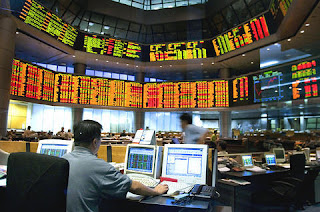Each common stock is assigned
 a trading symbol. The trading symbol of above table is Com. NB. The 52 week 'Hi' and 'Lo' prices are adjusted to reflect the common stock. 'Hi' means high price of the 52 weeks and 'Lo' means lowest price of the 52 dividends, based on the year-end, semiannual or annual declaration, by the closing price. The price-earning ratio or P/E ratio is calculated by dividing the closing price by the earning per share. The trading volume, 'vol 100s' gives the number of shares traded for the day. 'Net Chg' indicates the change in price form the previous day's close.
a trading symbol. The trading symbol of above table is Com. NB. The 52 week 'Hi' and 'Lo' prices are adjusted to reflect the common stock. 'Hi' means high price of the 52 weeks and 'Lo' means lowest price of the 52 dividends, based on the year-end, semiannual or annual declaration, by the closing price. The price-earning ratio or P/E ratio is calculated by dividing the closing price by the earning per share. The trading volume, 'vol 100s' gives the number of shares traded for the day. 'Net Chg' indicates the change in price form the previous day's close.The Secondary market
The role of secondary market is more in focus than that of primary market in securities market. It is mainly due to the fact that secondary market provides liquidity to the securities and ensures continuous price formation. The continous price formation process reduces sudden jump in the price of the securities in the market. Moreover, the operation of secondary market is also important from investors' point of view on the following grounds;
- The need for liquidity to meet sudden demands for funds due to premature payment of liabilities.
- The need to shuffle portfolio to readjust the maturity structure to realign with the current liability structure.
- The investors' decision to inform the portfolio returns by shedding some securities which are yielding lower income and going in for other securities which yield higher income.
- The need to constantly seize the opportunities available in the secondary market due to forces of demand and supply of certain securities.
Nepal Stock Exchange (NEPSE) is the only organized exchange to carry out secondary market operation of corporate securities in Nepal. The dashing leadership and internal management improvement are going on within working style of NEPSE to support automation in a stock requiring all brokers to conduct securities transactions through computer networks. Therefore, the following section describes the organization and operation of Nepal Stock Exchange Ltd.
Over-the-counter (OTC) Market
Over-the-counter market is a nebulous market made of brokers and dealers and the most important characteristic of the over-the-counter market is that the securities are not listed like that in organized stock exchange. It is popularly called as over-the-telephone market since the bulk of securities transactions are handled through the telephone. In implication, OTC is more a way to do business than it is a place. The telecommunication networks have made OTC market a loosely knit organization of brokers and dealers. In other words, most of the brokers and dealers who trade in an OTC market securities are linked by a networks of telephones, telegraphs, teletypewriters, computer system and others to deal directly with one another and with customers. In our country also, rethinking is going on to provide market for securities not listed in NEPSE. Laws and guidelines are initiated from SEBON. OTC market for de-listed securities rather it is to be understood that it is market place over communication lines derives the prices and it constitutes the main market maker in securities. OTC market performs mainly three important functions as given below;
- Providing market for outstanding securities
- Creating market for new issues
- Asking a market for secondary distributions.
Like that of listed securities in organized stock exchange, OTC market, securities traded range from the risk-free government securities to the most speculative common stocks. The OTC market is regulated by the National Association of Security Dealers (NASM). The broker dealers are also sometimes called registered representatives who are eligible to join NASD. In fact, NASD acts as a self-regulating agency for its members and put into operation the NASD Automated Quotation System (NASDAQ). As such, the nation-wide communication system networks allows brokers to know the terms currently offered and also made aware of current bid and asked prices for thousand of securities simply by pressing of the keys on a console of an electric type writer. Prices in OTC market are determined by direct negotiation between buyers and sellers through bid and asked prices. There is super dot providing electronic order routing system through member firms transmits market orders to exchange order management system. In fact under OTC, there is opening feature of super dot system.
The OTC market is not physically located in any one place. Rather it consists of a number of brokers, dealers, market makers throughout the country who are linked together through their communication network. For any individual security traded in OTC market, there will typically be a number of broker or dealer firms which make market in the security by setting competitive bid quotes to buy and ask quotes to sell the security.
Securities traded in the OTC market tend to be those of small regional business, banks, Finance companies and mutual funds. In addition most corporate and Nepal Government, bonds are traded in the OTC market. Here securities exchange center from the very beginning of its establishment started developing an over the counter market for government bonds, Initially because of the low public awareness and general participation towards these securities, it could not make such headway. However, afterward with the intensive marketing and dissemination of information and publicity took place about the investment in financial assets like bonds and government treasury bills. It broke the initial investor's resistance with the turnover of Rs.878 million transaction of government bond in 1992/93 as against Rs.372 million in 1980/81. But now a day, the scenario is totally changed. Market report reflects that demand for government security as well as bonds is in the process of development. It indicates the importance of Over-the-Counter market.




















